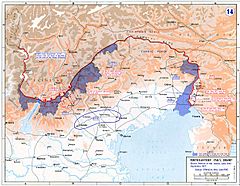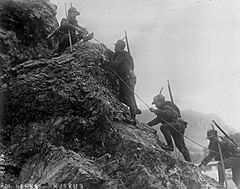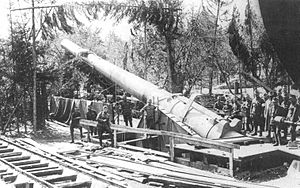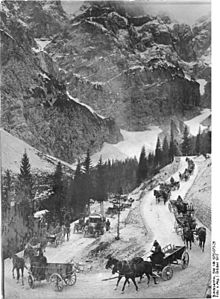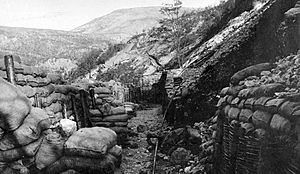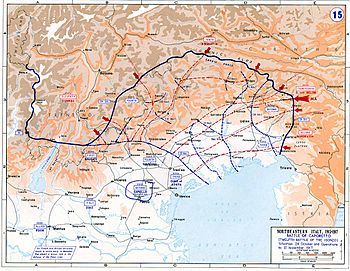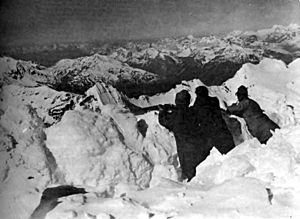Italian front (World War I) facts for kids
Quick facts for kids Italian front |
|||||||
|---|---|---|---|---|---|---|---|
| Part of the European theatre of World War I | |||||||
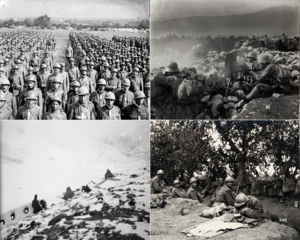 Clockwise: Italian soldiers listening to their General's speech; Austro-Hungarian trench on the Isonzo; Austro-Hungarian trench in the Alps; Italian trench on the Piave |
|||||||
|
|||||||
| Belligerents | |||||||
|
|
|
||||||
| Commanders and leaders | |||||||
| Strength | |||||||
1915 – up to 58 divisions 1917 – 3 divisions 1918 – 2 divisions 1918 – 5 regiments 1918 – 3 regiments 1918 – 1 regiment |
1915 – up to 61 divisions 1917 – 5 divisions |
||||||
| Casualties and losses | |||||||
316,789 killed 946,640 wounded 569,210 captured 1,057 killed 4,971 wounded 670 missing/captured 480 killed (700 died indirectly) 2,302 wounded unknown captured |
155,350 killed 175,041 missing 560,863 wounded 477,024 captured |
||||||
| 589,000 Italian civilians died of war-related causes | |||||||
The Italian Front was a major battle area during World War I. It involved many fights in Northern Italy between the Central Powers (like Austria-Hungary and Germany) and the Allies of World War I (like Italy, Britain, and France). These battles took place from 1915 to 1918.
Italy joined the war on the Allied side after secret promises were made in the 1915 Treaty of London. Italy hoped to take control of certain areas like the Austrian Littoral, northern Dalmatia, and parts of present-day Trentino and South Tyrol.
Even though Italy hoped for a quick victory, the fighting soon turned into trench warfare. This was similar to the Western Front, but it happened in very high mountains. Winters were extremely cold. The war forced many local people to leave their homes. Thousands of civilians died from hunger and sickness in refugee camps.
The Allies won the Battle of Vittorio Veneto. This led to the collapse of Austria-Hungary. Italy also captured Trento and Trieste. All fighting on this front ended by November 1918. The armistice of Villa Giusti officially stopped the fighting on November 4, 1918. Some Italians called this war the Fourth Italian War of Independence. This is because it helped complete the unification of Italy.
Contents
History of the Italian Front
Before the War Began
- 1908 - Bosnian Crisis: Italy expected to gain land from Austria-Hungary as a trade-off for Austria-Hungary taking over Bosnia-Herzegovina. This was part of their agreement in the Triple Alliance. But this didn't happen. This disagreement was one reason Italy later broke its alliance with Austria-Hungary in 1915.
- 1911 - Libyan War: This war weakened the Ottoman Empire. It also made Italy less friendly with its Triple Alliance partners, Germany and Austria-Hungary. Germany saw the Ottomans as an ally.
- 1914 - June 28: Archduke Franz Ferdinand was killed in Sarajevo. He was the heir to the Austro-Hungarian throne. This event sparked World War I.
- 1914 - July: The "July Crisis" began. Austria-Hungary decided to act against Serbia. They did not tell Italy or Romania, even though they were allies. This broke a rule in the Triple Alliance.
- 1914 - August 2: Italy declared that it would remain neutral, meaning it would not join the war. This was allowed by the Triple Alliance treaty.
- 1914 - November 5: Sidney Sonnino became Italy's Foreign Minister. He pushed Austria-Hungary to give Italy land as agreed in their alliance. Austria-Hungary offered to give up Trentino, but their Emperor and Prime Minister refused.
- 1915 - March 3: Italian leaders Antonio Salandra and Sidney Sonnino, with the King's support, offered to join the war on the side of the Triple Entente (Britain, France, and Russia).
- 1915 - April 26: The Treaty of London was signed. Britain, France, and Russia promised Italy land if it joined them in the war within a month. This treaty was kept secret.
- 1915 - May 4: Italy officially left the Triple Alliance with Germany and Austria-Hungary.
- 1915 - May 23: Italy declared war on Austria-Hungary.
Battles of 1915–1916
Before joining the war, Italy's military had problems with equipment and ammunition. These issues were not fixed by the time Italy entered World War I. At the start, Austro-Hungarian troops held strong positions in the Julian Alps and Karst Plateau. However, the Italians had more soldiers at first.
Isonzo Battles in 1915
Italy launched an attack to cross the Soča (Isonzo) river and capture the town of Gorizia. This started the first of many Battles of the Isonzo.
The First Battle of the Isonzo began on June 23, 1915. Italian forces outnumbered the Austrians three to one. But they could not break through the strong Austro-Hungarian defenses in the highlands. The Austrians were on higher ground, making Italian attacks very difficult. The battle ended on July 7, 1915, with little gain for Italy.
Italian units lacked good equipment and morale. Many soldiers disliked their commander, General Luigi Cadorna. Problems with supplies also slowed their progress. The Italian army used horses for transport, but struggled to get enough supplies to troops in the tough mountain terrain.
Two weeks later, on July 18, 1915, the Italians tried another attack, the Second Battle of the Isonzo. This time they had more artillery. In the northern part of the front, Italians managed to take Mount Batognica. This was an important spot for future battles. This bloody fight ended when both sides ran out of ammunition.
The Italians got more supplies and 1200 heavy guns. On October 18, 1915, they launched the Third Battle of the Isonzo. Austria-Hungary pushed back this attack. It ended on November 4 with no real gains.
Another Italian attack, the Fourth Battle of the Isonzo, began on November 10. Both sides had many casualties. The Italians captured some important trenches. The battle ended on December 2 because both sides were exhausted.
After a quiet winter, the Fifth Battle of the Isonzo started on March 9, 1916. The Italians captured the important Mount Sabatino. But Austria-Hungary stopped all other attacks. The battle ended on March 16 due to bad weather.
The Asiago Offensive
After Italy's attacks stalled, Austria-Hungary planned a counter-attack. This was the Battle of Asiago in Trentino. Their goal was to break through to the Po River plain. This would cut off Italian armies in the northeast. The attack began on May 15, 1916, with 15 divisions. They made some early gains. But the Italians fought back and pushed the Austro-Hungarians towards Tyrol.
Later Isonzo Battles
Later in 1916, four more battles happened along the Isonzo river. The Sixth Battle of the Isonzo, launched by Italy in August, was more successful than earlier attacks. It didn't gain much land, but it did capture Gorizia. This made Italian soldiers feel better. The Seventh, Eighth, and Ninth battles of the Isonzo (September 14 – November 4) achieved little. They mostly just wore down both armies.
Italian soldiers fought very often, about every three months, from May 1915 to August 1917. This was more often than armies on the Western Front. Discipline was also much stricter in the Italian army. Shellfire in the rocky mountains caused many more casualties than on the soft ground in Belgium and France. By late 1917, the Italian army had suffered most of its war deaths. The war seemed endless.
Tunnel Warfare in the Mountains

From 1915, the high peaks of the Dolomites mountains saw fierce mountain warfare. To protect soldiers from enemy fire and the harsh cold, both sides built fighting tunnels. These tunnels offered cover and helped with supplies. Building them in the hard rock and ice of the Dolomites needed great skill.
On December 13, 1916, known as White Friday, 10,000 soldiers died from avalanches in the Dolomites. Many avalanches were caused by artillery shells fired on the mountainside. Others happened naturally.
Besides building underground shelters and covered supply routes, both sides also tried to break the stalemate. They dug tunnels under no man's land and placed explosives under enemy positions. Between 1916 and 1918, 34 mines were set off in this area. Explosives ranged from 110 kg to 50,000 kg. In April 1916, Italians blew up explosives under Col Di Lana, killing many Austro-Hungarians.
1917: Germany Joins the Front
The Italians launched a two-part attack north and east of Gorizia. The Austrians stopped the eastern advance. But Italian forces under Luigi Capello broke through Austrian lines and captured the Banjšice Plateau. The Italians were close to victory, but their supplies could not keep up. They had to pull back. Despite heavy losses, the Italians had almost defeated the Austro-Hungarian army. This forced Austria-Hungary to ask Germany for help.
Austria-Hungary received much-needed help from German soldiers. These troops came after a Russian attack failed in July 1917. German troops also arrived from the Romanian front. The Germans brought new tactics to the Austro-Hungarian front. Meanwhile, Italian soldiers were losing hope and rebelling. They lived in bad conditions and fought many attacks that gained little.
On October 24, 1917, the Austro-Hungarians and Germans launched the Battle of Caporetto. They used gas shells and a huge artillery attack. Then, infantry used new tactics to go around strong enemy points and attack from behind. By the end of the first day, the Italians had retreated 12 miles (19 km).
As the Austro-Hungarian attack pushed the Italians back, the new Italian chief of staff, Armando Diaz, ordered them to stop. They defended strong positions around the Monte Grappa summit. Even though they had fewer soldiers, the Italian Army managed to stop the Austro-Hungarian and German armies in the First Battle of Monte Grappa.
1918: The War Ends
Second Battle of the Piave River (June 1918)
The Austro-Hungarians advanced quickly, but their supply lines could not keep up. They had to stop and regroup. The Italians were pushed back to defensive lines near Venice on the Piave River. By this point, Italy had suffered 600,000 casualties. Because of these losses, the Italian government called up the "99 Boys." These were young men born in 1899 who were turning 18 in 1917. In November 1917, British and French troops arrived to help. Even more important was the Allies' economic help, providing materials like steel and coal that Italy desperately needed. In spring 1918, Germany pulled its troops out to use them in a new attack on the Western Front. Britain and France also pulled back half of their divisions.
The Austro-Hungarians then debated how to finish the war in Italy. Their generals disagreed on how to carry out the final attack. Archduke Joseph August of Austria decided on a two-part attack. But it was impossible for the two forces to communicate in the mountains.
The Second Battle of the Piave River began with a small attack near the Tonale Pass. The Italians pushed it back. Austrian deserters told the Italians about the upcoming main attack. This allowed Italy to move two armies directly into the path of the Austrian forces. The other part of the attack, led by General Svetozar Boroević von Bojna, had some early success. But then planes bombed their supply lines, and Italian reinforcements arrived.
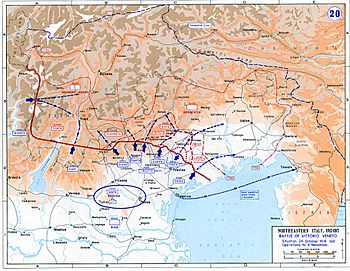
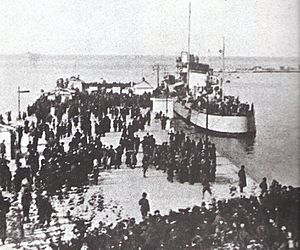
The Decisive Battle of Vittorio Veneto (October–November 1918)
Italy's allies were disappointed that no counter-attack followed the Battle of Piave. The Italian Army had suffered huge losses and thought another attack would be too risky. General Armando Diaz waited for more help from the Western Front. By late October 1918, Austria-Hungary was in a terrible situation. Czechoslovakia, Croatia, and Slovenia declared their independence. Parts of their troops started leaving, disobeying orders, and retreating. Many Czechoslovak troops even began fighting for the Allies.
By October 1918, Italy finally had enough soldiers to launch an attack. The target was Vittorio Veneto, across the Piave River. The Italian Army broke through a gap near Sacile. They sent in many more soldiers, which crushed the Austro-Hungarian defense. On October 31, the Italian Army launched a full attack, and the entire front began to fall apart. On November 3, 300,000 Austro-Hungarian soldiers surrendered. On the same day, the Italians entered Trento and Trieste, where people welcomed them.
On November 3, the military leaders of the collapsing Austria-Hungary asked the Italian commander for a ceasefire and peace terms. The terms were agreed upon with the Allies in Paris. The Armistice with Austria was signed in Villa Giusti, near Padua, on November 3. It took effect at 3:00 PM on November 4. Austria and Hungary signed separate agreements after the fall of the Habsburg monarchy and the end of the Austro-Hungarian Empire.
Casualties of the War
About 531,000 Italian soldiers died in the war. This included officers and enlisted men. Of these, many came from Northern, Central, and Southern Italy.
About 155,350 Austro-Hungarian soldiers were killed in action. This number increased each year of the war. For Italian soldiers, 66,090 were killed in 1915, 118,880 in 1916, 152,790 in 1917, and 40,250 in 1918.
Occupation of Northern Dalmatia and Tyrol
By the end of the war in November 1918, the Italian military had taken control of all the land in Dalmatia that had been promised to Italy by the London Pact. Italian forces reached islands like Lissa and Lagosta, and coastal towns like Sebenico. In 1918, Admiral Enrico Millo declared himself Italy's Governor of Dalmatia. After November 4, the Italian military also occupied Innsbruck and all of Tyrol with about 20,000-22,000 soldiers.
Images for kids
See also
 In Spanish: Frente italiano (Primera Guerra Mundial) para niños
In Spanish: Frente italiano (Primera Guerra Mundial) para niños
- Austro-Hungarian fortifications on the Italian border
- Museum of the White War in Adamello - located in Temù, in the Upper Val Camonica.
- White War


